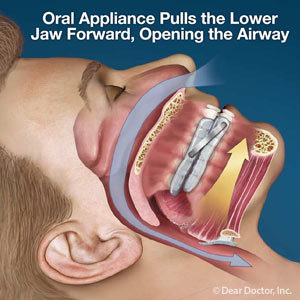
More Dental Health Articles
Alternate Options For Sleep Apnea

CPAP Is Not the Only Option
Sleep apnea, a serious condition characterized by intermittent cessation of breathing during sleep, is commonly addressed with CPAP (continuous positive airway pressure), also known as “the mask.” However, CPAP may not be suitable for everyone due to its inconvenience and discomfort, leading about half of the patients to discontinue its use. Fortunately, there are alternative treatments available, including surgical interventions, implanted stimulation devices, weight loss, and oral appliances.
Oral appliances, initially designed to alleviate snoring, are now prescribed for mild to moderate cases of sleep apnea and individuals who cannot tolerate CPAP. These appliances have reported success rates of up to 85% and offer a considerably higher level of comfort for patients.
Various types of oral appliances are designed to address sleep apnea, with the most common ones functioning by positioning the lower jaw and tongue forward. This repositioning creates additional space at the back of the throat, where obstructions commonly occur. While older and over-the-counter oral appliances used to be bulky, advancements in technology have enabled dentists to create lightweight, custom-fitted devices that are both effective and durable. Many patients prefer these newer options, such as the Panthera appliance, over the older bulkier devices and CPAP machines.
A recent innovation in oral appliances is the DNA (day and night) appliance, which can potentially cure sleep apnea in certain cases. This appliance stimulates the growth of the upper jaw, thereby creating more room for the tongue and expanding the space at the back of the throat. As the upper jaw grows, the roof of the mouth tends to flatten, allowing for better nasal breathing (as the roof of the mouth corresponds to the floor of the nose). Since DNA treatment can be a lengthy process, a modified version called the mRNA (mandibular repositioning night appliance) can be used to hold the jaw forward until the upper jaw has widened enough to accommodate the tongue.
Personally, I have experience with all these appliances. I used one of the older bulky devices for many years to address my snoring. When I later developed sleep apnea, I switched to a more modern appliance similar to the Panthera, which proved comfortable and effective. Upon learning about the DNA appliance, I underwent the necessary training and tried it myself. Although it took over a year, I managed to eliminate my sleep apnea through moderate growth of my upper jaw.
When dealing with any medical condition, it is crucial to explore all available options and understand that what works perfectly for one patient may not be suitable for another.
Other Articles You May Find of Interest...
- Let’s Smile Dental’s 7&Up Club
- Strengthening Smiles: Understanding the Importance of Splinting Periodontally Involved Teeth
- Understanding Soft Tissue Grafting: A Key To Periodontal Health
- New Solutions for Dentures and Dental Implants
- Benefits Of Immediate Dental Implants
- Preventing Tooth Injuries During Your Child’s Active Summer
- How New Tech In the Dental Office Benefits You

















